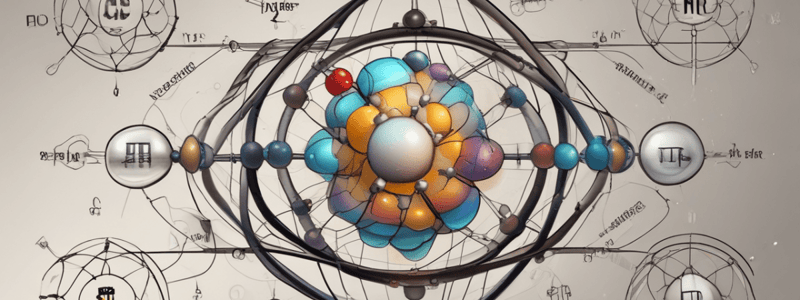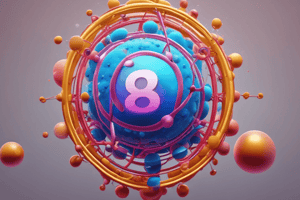Podcast
Questions and Answers
What is the smallest component of a substance that cannot be divided into smaller substances without losing its properties?
What is the smallest component of a substance that cannot be divided into smaller substances without losing its properties?
- Nucleus
- Atom (correct)
- Molecule
- Element
What does the nucleus contain?
What does the nucleus contain?
- Protons and electrons
- Protons and neutrons (correct)
- Electrons and protons
- Electrons and neutrons
Atoms with different numbers of neutrons in their nuclei are called:
Atoms with different numbers of neutrons in their nuclei are called:
- Compounds
- Isotopes (correct)
- Molecules
- Elements
How many electrons can be held in the second shell?
How many electrons can be held in the second shell?
What is an isotope of oxygen with an atomic number of 8 and an atomic weight of 18?
What is an isotope of oxygen with an atomic number of 8 and an atomic weight of 18?
What are the building blocks of proteins?
What are the building blocks of proteins?
Which of the following are purines?
Which of the following are purines?
Which nitrogenous base is NOT found in an RNA molecule?
Which nitrogenous base is NOT found in an RNA molecule?
Why do saturated fats become solid more easily than unsaturated fats?
Why do saturated fats become solid more easily than unsaturated fats?
How many neutrons does an isotope of oxygen with an atomic number of 8 and an atomic weight of 18 have?
How many neutrons does an isotope of oxygen with an atomic number of 8 and an atomic weight of 18 have?
Which type of bond is weak and does NOT bind atoms into molecules?
Which type of bond is weak and does NOT bind atoms into molecules?
What is the term for the number of extra or missing electrons in an atom's outermost electron shell?
What is the term for the number of extra or missing electrons in an atom's outermost electron shell?
What is a bond formed from the attraction between ions of opposite charge called?
What is a bond formed from the attraction between ions of opposite charge called?
Which term describes a molecule that contains at least two different kinds of atoms?
Which term describes a molecule that contains at least two different kinds of atoms?
Which term refers to a molecule that contains at least two different kinds of atoms?
Which term refers to a molecule that contains at least two different kinds of atoms?
What is formed by the sharing of electrons?
What is formed by the sharing of electrons?
Which type of molecule has an unequal distribution of charges?
Which type of molecule has an unequal distribution of charges?
What does NOT correctly describe inorganic compounds?
What does NOT correctly describe inorganic compounds?
Which compound helps keep the pH from changing drastically?
Which compound helps keep the pH from changing drastically?
What is the name for a molecule that contains at least two different kinds of atoms?
What is the name for a molecule that contains at least two different kinds of atoms?
Which type of bond is formed by the sharing of electrons?
Which type of bond is formed by the sharing of electrons?
What category does water fall under due to its unequal charge distribution?
What category does water fall under due to its unequal charge distribution?
Which type of carbohydrates are glycogen, dextran, and cellulose examples of?
Which type of carbohydrates are glycogen, dextran, and cellulose examples of?
What is the primary structure in proteins?
What is the primary structure in proteins?
What is the secondary structure in proteins mainly defined by?
What is the secondary structure in proteins mainly defined by?
In which level of protein structure do you find alpha helices and beta sheets?
In which level of protein structure do you find alpha helices and beta sheets?
What type of bond stabilizes the tertiary structure of proteins?
What type of bond stabilizes the tertiary structure of proteins?
Which level of protein structure involves the overall 3D shape of a protein with multiple polypeptide chains?
Which level of protein structure involves the overall 3D shape of a protein with multiple polypeptide chains?
What type of carbohydrates are glucose and fructose examples of?
What type of carbohydrates are glucose and fructose examples of?
What do cellulose, chitin, and starch have in common?
What do cellulose, chitin, and starch have in common?
Study Notes
Atomic Structure
- An isotope of oxygen has an atomic number of 8 and an atomic weight of 18, and it has 10 neutrons.
- The nucleus contains protons and neutrons.
- Atoms with different numbers of neutrons in their nuclei are called isotopes.
Bonding
- A bond formed from the attraction between ions of opposite charge is called an ionic bond.
- A weak bond that does not bind atoms into molecules is a hydrogen bond.
- Covalent bonds are formed by the sharing of electrons.
- A bond that is not formed by the sharing of electrons is an ionic bond or a hydrogen bond.
Molecules and Compounds
- A molecule that contains at least two different kinds of atoms is called a compound.
- A molecule that contains only one kind of atom is not a compound.
- Water has an unequal distribution of charges and is called a polar molecule.
Chemical Principles
- The smallest component of a substance that cannot be divided into smaller substances without losing its properties is an atom.
- The number of extra or missing electrons in an atom's outermost electron shell is called the atom's valence.
- The second shell of an atom can hold 8 electrons.
Biomolecules
- Amino acids are the "building blocks" of proteins.
- Adenine and guanine are purines, which are types of nitrogenous bases.
- Thymine is not found in an RNA molecule.
- Saturated fats become solid more easily than unsaturated fats because of the double bonds in their chains.
- Glycogen, dextran, and cellulose are examples of polysaccharides.
- The overall three-dimensional structure of a polypeptide chain is called the tertiary structure of a protein.
Acids and Bases
- A compound that helps keep the pH from changing drastically is a buffer.
- Inorganic compounds are usually small, structurally simple, and do not contain carbon.
Studying That Suits You
Use AI to generate personalized quizzes and flashcards to suit your learning preferences.
Related Documents
Description
Test your knowledge of chemistry with questions about isotopes, atomic numbers, and types of chemical bonds. Learn about the elements and their properties in this quiz.




